Crinoidea |
Comatulida |
Mariametridae
Environment: milieu / climate zone / εύρος βάθους / distribution range
Οικολογία
; εύρος βάθους 0 - 73 m (Αναφ. 81020). Tropical
Indo-West Pacific.
Length at first maturity / Μέγεθος / Weight / Age
Γεννητική Ωρίμανση: Lm ? range ? - ? cm
Occurs in tidepools (Ref. 101028). Subtidal on rocky outcrops at daylight (Ref. 102838). It is usually cryptic under rubble and at the reef during the day (Also Ref. 129602); it gets active at dusk, crawling to exposed perches and spreading its arms in a biplanar posture (Ref. 101028). Also found under dead and living corals (Refs. 100368, 129602). Suspension feeder (Ref. 68823).
Life cycle and mating behavior
Γεννητική Ωρίμανση | Αναπαραγωγή | Γεννοβολία | Eggs | Γονιμότητα | Larvae
Members of the class Crinoidea are gonochoric. During spawning, the pinnule walls rupture and the eggs and sperms are shed into the seawater. Life cycle: Embryos elongate into free-swimming larvae (doliolaria) which later sink to the bottom where they metamorphose into stalked sessile crinoid.
Putchakarn, S. and P. Sonchaeng 2004 Echinoderm fauna of Thailand: history and inventory reviews. Science Asia 30:417-428. (Αναφ. 2534)
IUCN Red List Status
(Αναφ. 130435: Version 2025-1)
CITES status (Αναφ. 108899)
Not Evaluated
Not Evaluated
Threat to humans
Harmless
Human uses
| FishSource |
Εργαλεία
Περισσότερες πληροφορίες
Τροφική ΟικολογίαFood items (preys)
Σύσταση δίαιτας
Κατανάλωση τροφής
Θηρευτές
Population dynamicsΑύξηση
Max. ages / sizes
Length-weight rel.
Length-length rel.
Length-frequencies
Mass conversion
Αφθονία
Life cycleΑναπαραγωγήΓεννητική ΩρίμανσηΓονιμότηταΓεννοβολίαEggsEgg developmentLarvae PhysiologyΚατανάλωση οξυγόνου
Human RelatedStamps, coins, misc.
Διαδικτυακές πηγές
Estimates based on models
Preferred temperature
(Ref.
115969): 24.4 - 28.9, mean 27.7 (based on 880 cells).
